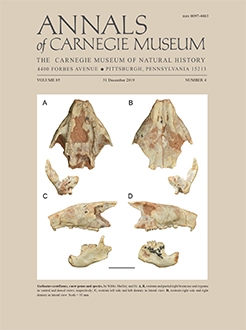John R. Wible, Sarah L. Shelley, Shundong Bi
Annals of Carnegie Museum 85 (4), 285-327, (31 December 2019) https://doi.org/10.2992/007.085.0401
KEYWORDS: Bayan Mandahu Formation, Djadochtatheriidae, Djadochtatherioidea, Guibaatar castellanus, multituberculate
The superfamily Djadochtatherioidea is a distinctive clade of multituberculates from Upper Cretaceous beds of Mongolia and Inner Mongolia, China. Because many of the 11 included genera are known from skulls, more is known about the cranial anatomy of djadochtatherioids than any other clade of multituberculates. Within Djadochtatherioidea, the most diverse and widely accepted group is the family Djadochtatheriidae. Within the family, the basal genus, KryptobaatarKielan-Jaworowska, 1970, is small with a skull length of about 30 mm, whereas the other four genera, DjadochtatheriumSimpson, 1925, CatopsbaatarKielan-Jaworowska, 1994, TombaatarRougier et al., 1997, and MangasbaatarRougier et al., 2016, have skulls approximately twice as long. Here, we describe a new genus and species, Guibaatar castellanus, based on a single specimen from the Upper Cretaceous Bayan Mandahu Formation, Inner Mongolia that we refer to Djadochtatheriidae. Guibaatar is represented by a relatively complete rostrum, a partial right braincase, and partial lower jaws. As revealed by CT scanning, the specimen is a juvenile, with deciduous enlarged upper and lower incisors with permanent replacements forming, m2 erupting, and M2 forming. Based on the preserved cranial parts, we estimate the skull length to be approximately 50 mm, but as an adult, Guibaatar would have been in the size range of the larger djadochtatheriids.
Phylogenetic analysis including Guibaatar, known djadochtatherioids, and outgroups places Guibaatar within Djadochtatheriidae, as sister to a clade of Mangasbaatar and Catopsbaatar. We suspect the relationships of djadochtatherioids are likely to be refined given the announcements by other researchers that skulls are known for the djadochtatheriids Tombaatar and Djadochtatherium, which were previously represented by incomplete material.

